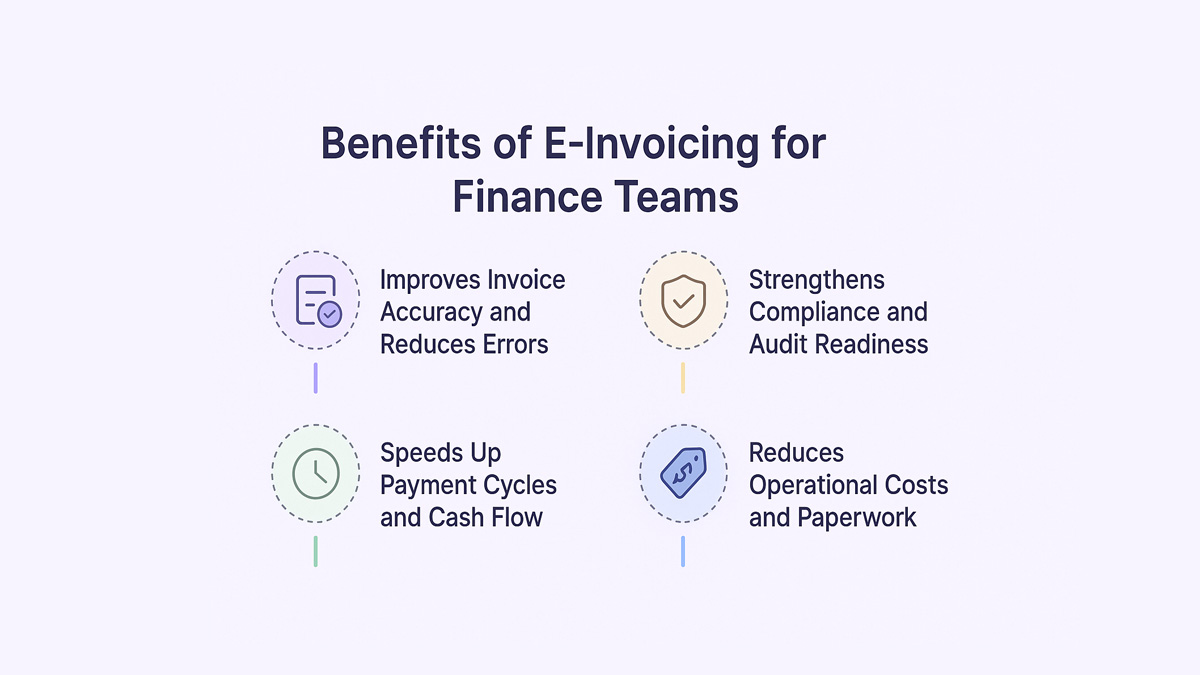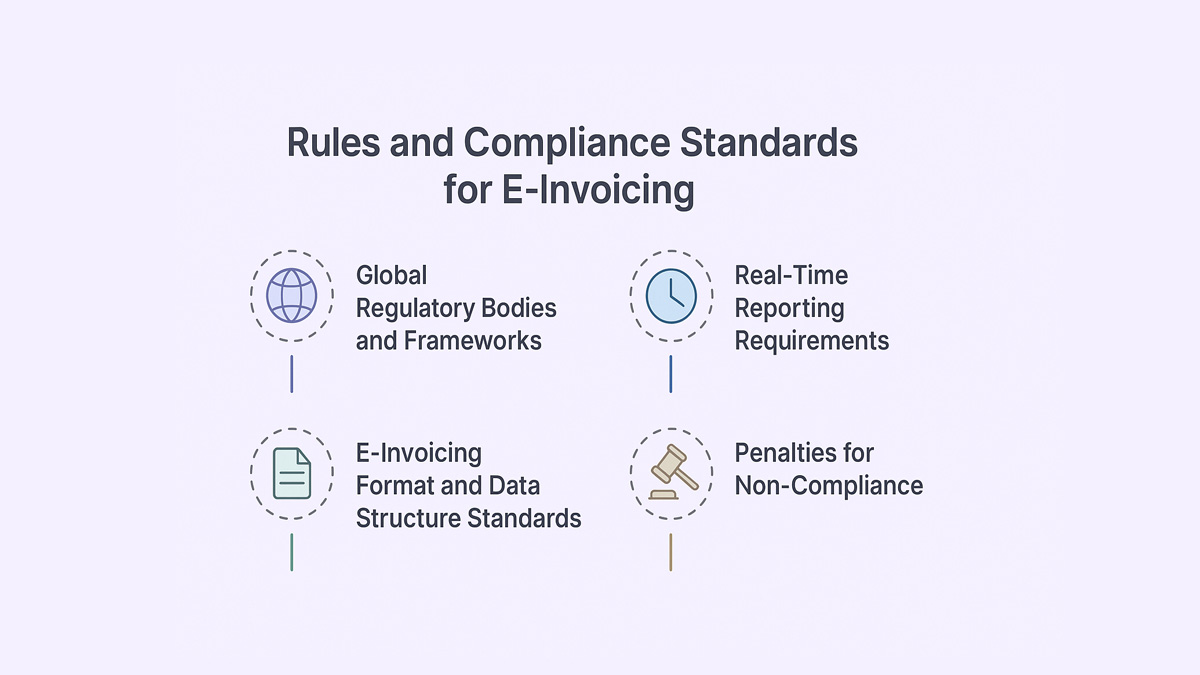

The Future of E-Invoicing: Understanding E-Invoicing Regulations

The Future of E-Invoicing: Understanding E-Invoicing Regulations
Explore key e-invoicing regulations, compliance challenges, and how modern finance teams can stay compliant across global operations.


As finance teams become more digital, invoicing - once a paper-heavy, error-prone process - is now under the microscope. Governments around the world are mandating electronic invoicing to close tax gaps, curb fraud, and boost efficiency. But while the benefits are real, navigating these fast-evolving regulations can be overwhelming - especially for companies operating globally.
What this blog covers:
- What is electronic invoicing (e-invoicing)
- Top benefits of e-invoicing for modern finance teams
- Why governments are introducing global e-invoicing mandates
- How e-invoicing impacts U.S. companies with international operations
- Key rules and compliance standards businesses must follow
- Mandatory fields required in a compliant e-invoice
- The difference between e-billing and e-invoicing
- How Spendflo helps ensure e-invoicing compliance
- Frequently asked questions on e-invoicing compliance
What is Electronic Invoicing (E-Invoicing)?
Electronic invoicing (e-invoicing) is the digital exchange of invoice documents between buyers and suppliers using a standardized format. It automates invoicing from creation to approval and storage, often integrating with ERP or accounting systems. Unlike PDFs or scanned copies, true e-invoices are structured data files validated in real time for compliance, accuracy, and audit-readiness.
Top Benefits of E-Invoicing for Modern Finance Teams
Adopting e-invoicing isn’t just about checking a compliance box - it’s about unlocking smarter, faster, and more efficient finance operations. When done right, it frees up time, reduces risk, and strengthens the backbone of your financial workflows. This shift allows finance teams to streamline invoice processing and reduce operational overhead.
Here are the top benefits of e-invoicing for modern finance teams:

Improves Invoice Accuracy and Reduces Errors
Manual data entry is a breeding ground for mistakes - missing line items, duplicate entries, incorrect totals. E-invoicing systems automatically capture and validate data at the source, slashing errors and rework. Fewer discrepancies also mean fewer back-and-forth emails with vendors.
Speeds Up Payment Cycles and Cash Flow
With automated invoice submission, validation, and approval, finance teams can significantly shorten their processing timelines. Faster approvals mean quicker payments, stronger vendor relationships, and better control over cash flow - no more waiting weeks just to route a paper invoice.
Strengthens Compliance and Audit Readiness
Most e-invoicing platforms are built to align with regional tax laws and global compliance standards. This means every invoice is automatically checked for legal fields, digital signatures, and format requirements - making audit prep less of a scramble and more of a routine check.
Reduces Operational Costs and Paperwork
Say goodbye to printing, scanning, mailing, and storing paper invoices. Beyond efficiency, digital invoicing leads to significant cost savings across the accounts payable function. E-invoicing cuts costs associated with physical processing and lowers the administrative burden. It’s not just leaner - it’s greener too.
Why Are E-Invoicing Mandates Being Introduced Globally?
Governments across the globe are pushing e-invoicing not just as a modernization effort - but as a strategic lever to close financial loopholes, reduce tax fraud, and streamline economic oversight. These efforts are being formalized through government mandates that set strict digital invoicing standards.
One major reason is the need for real-time tax reporting. Traditional invoice processes often delay the detection of discrepancies, allowing room for manipulation or fraud. With e-invoicing, tax authorities can receive invoice data instantly, ensuring transparency and accuracy from day one.
Another driver is global standardization. Countries like Italy, India, Mexico, and more recently France and Germany, are adopting structured formats like PEPPOL or country-specific XML schemas. These frameworks allow for more consistent reporting and easier cross-border trade audits. Most governments require invoices to be submitted in an approved electronic format to meet compliance.
Lastly, there’s a broader push toward digital transformation in public finance. E-invoicing paves the way for governments to automate VAT collection, reduce administrative overheads, and increase visibility into business transactions - resulting in more efficient and resilient economies. As digital invoicing becomes more mainstream, it also supports broader initiatives in public sector reform.
How E-Invoicing Impacts U.S. Companies with Global Operations
For U.S.-based companies, global expansion comes with more than just currency exchange and logistics challenges - it brings a complex web of e-invoicing compliance requirements.
Unlike the U.S., where e-invoicing isn’t yet federally mandated, many countries in Europe, Latin America, and Asia-Pacific require it by law. This means American companies operating or selling in those regions must adhere to each country’s unique specifications - whether it’s real-time invoice submission to tax portals (like India’s IRP system) or using government-approved formats (like Italy’s FatturaPA).
What complicates things further is integration. Global businesses often run multiple ERPs or finance systems across regions. Integrating e-invoicing with ERP systems can ensure consistency and visibility across borders. Making sure each system can generate, send, and archive compliant e-invoices for every jurisdiction requires careful planning - and a deep understanding of local rules.
In short, global operations now demand more than just financial agility - they require a compliance-first approach to invoicing, tailored to each market’s regulations. This shift has a direct impact on how companies design and manage their core Business Processes.
What Are the Key Rules and Compliance Standards for E-Invoicing?
E-invoicing compliance isn’t just about digitizing invoices - it’s about meeting strict legal, technical, and procedural standards. These rules vary by country but typically revolve around who receives the invoice data, how it’s formatted, and when it must be submitted.
Here are the key standards and regulations finance teams need to watch:

Global Regulatory Bodies and Frameworks
Different countries operate under their own e-invoicing mandates. The European Union promotes the PEPPOL framework, while countries like Mexico and Brazil have long used government portals for invoice validation. Keeping up with each region’s legal landscape is critical for staying compliant.
E-Invoicing Format and Data Structure Standards
Most e-invoices must be generated in machine-readable formats such as XML or UBL. These formats follow specific schemas that define which fields are mandatory, how data is structured, and how it should be validated. Ensuring compatibility with accounting software is key to automating end-to-end invoice workflows. Non-compliance often results in invoice rejection at the government or buyer level.
Real-Time Reporting Requirements
Several jurisdictions mandate real-time or near real-time invoice submission to tax authorities. This means invoices must be reported as soon as they’re issued - not days or weeks later. Digital reporting enables real-time visibility for both companies and tax authorities. It’s a game-changer for how finance teams handle invoice timing and approvals.
Penalties for Non-Compliance
Failure to comply with e-invoicing rules can lead to delayed payments, invoice rejection, or even regulatory fines. Keeping track of evolving regulatory requirements is essential to avoid penalties in different jurisdictions. In some countries, repeat violations can escalate into tax audits or supplier blacklisting.
Mandatory Fields Required in a Valid E-Invoice
Every e-invoice must follow a strict format with predefined fields to ensure it passes legal and technical validations. These aren’t optional - they’re essential for regulatory compliance and smooth processing. Electronic invoices also reduce the risk of manual data entry errors that could delay approvals.
Here are the key fields most countries and systems require:
Taxpayer Identification Numbers
Both the buyer’s and seller’s tax identification numbers (TIN, VAT ID, or GSTIN depending on the region) must be included. These unique identifiers help authorities match transactions to registered entities.
Invoice Line Item Details
Each product or service listed on the invoice must include quantity, unit price, tax rate, and total amount. These details must follow a structured digital format to pass system validations. Descriptions should be specific and match what’s agreed in the purchase order or contract.
Payment Terms and Due Dates
Clear payment terms - including due date, penalties for late payment, and currency - are required. This ensures legal clarity and consistency in accounts payable workflows.
Digital Signatures and Authentication
Many countries mandate digital or electronic signatures to verify invoice authenticity. These are often generated using government-authorized certificates or cryptographic keys.
These fields not only help ensure compliance but also improve data accuracy and automation in downstream finance processes. This structured approach brings a new level of control to downstream financial processes. Digital reporting enables real-time visibility for both companies and tax authorities.
E-Billing vs. E-Invoicing: What’s the Difference?
Though often used interchangeably, e-billing and e-invoicing aren’t the same. The key difference lies in structure, purpose, and regulatory alignment.
E-billing is a digital version of the traditional invoice. E-invoicing is built for automation and compliance. Knowing the difference is crucial - especially when governments demand the latter.
How Spendflo Helps with E-Invoicing Compliance
Spendflo simplifies the complexity of global e-invoicing compliance by embedding regulatory standards directly into your procurement workflows. From mapping mandatory invoice fields to automating real-time validations, Spendflo ensures every invoice you generate meets country-specific laws. It also streamlines invoice generation across departments and geographies. It centralizes all your vendor and invoice data in one place, helps eliminate manual errors, and enables secure, compliant, and audit-ready invoicing - no matter where you operate.
Frequently Asked Questions on E-Invoicing Compliance
What are the common compliance mistakes in e-invoicing?
The most common pitfalls include missing mandatory fields, using incorrect invoice formats, failing to submit invoices on time, and not adhering to country-specific digital signature requirements. These errors often lead to rejected invoices and delayed payments.
How does e-invoicing differ across countries?
Each country sets its own compliance rules. Regulatory mandates define how and when companies must transmit invoice data electronically. For example, Italy requires invoices to be submitted through the SDI system in XML format, while India mandates IRN generation and QR codes via the Invoice Registration Portal. Businesses must localize their processes accordingly.
Can e-invoicing be integrated with legacy systems?
Yes, many e-invoicing solutions offer APIs or middleware that integrate with legacy ERP or accounting systems. However, older systems may require custom development or third-party support to meet real-time compliance standards.
What happens if you fail to comply with e-invoicing mandates?
Non-compliance can result in rejected invoices, payment delays, tax penalties, and in some regions, legal scrutiny or audits. Chronic failure may even lead to vendor disqualification or business disruption.
Is e-invoicing mandatory in the U.S.?
As of now, the U.S. does not have a federal e-invoicing mandate. However, businesses operating globally must comply with international e-invoicing laws in regions where it is mandatory. There is growing momentum for standardization even in the U.S. market.










.png)




.png)










.avif)





